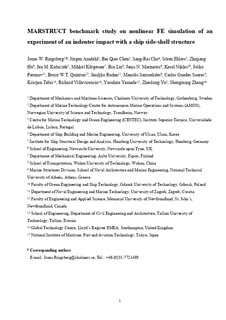| dc.contributor.author | Ringsberg, Jonas W | |
| dc.contributor.author | Amdahl, Jørgen | |
| dc.contributor.author | Chen, Bai Qiao | |
| dc.contributor.author | Cho, Sang-Rai | |
| dc.contributor.author | Ehlers, Sören | |
| dc.contributor.author | Hu, Zhiqiang | |
| dc.contributor.author | Kubiczek, Jan M | |
| dc.contributor.author | Korgesaar, Mihkel | |
| dc.contributor.author | Liu, Bin | |
| dc.contributor.author | Marinatos, Janis N | |
| dc.contributor.author | Niklas, Karol | |
| dc.contributor.author | Parunov, Joško | |
| dc.contributor.author | Quinton, Bruce WT | |
| dc.contributor.author | Rudan, Smiljko | |
| dc.contributor.author | Samuelides, Manolis | |
| dc.contributor.author | Soares, Carlos Guedes | |
| dc.contributor.author | Tabri, Kristjan | |
| dc.contributor.author | Villavicencio, Richard | |
| dc.contributor.author | Yamada, Yasuhira | |
| dc.contributor.author | Yu, Zhaolong | |
| dc.contributor.author | Zhang, Shengming | |
| dc.date.accessioned | 2019-11-26T10:13:12Z | |
| dc.date.available | 2019-11-26T10:13:12Z | |
| dc.date.created | 2019-02-01T15:19:08Z | |
| dc.date.issued | 2018 | |
| dc.identifier.citation | Marine Structures. 2018, 59 142-157. | nb_NO |
| dc.identifier.issn | 0951-8339 | |
| dc.identifier.uri | http://hdl.handle.net/11250/2630457 | |
| dc.description.abstract | This paper presents a benchmark study on collision simulations that was initiated by the MARSTRUCT Virtual Institute. The objective was to compare assumptions, finite element models, modelling techniques and experiences between established researchers within the field. Fifteen research groups world-wide participated in the study. An experiment involving a rigid indenter penetrating a ship-like side structure was used as the case study. A description of how the experiment was performed, the geometry model of it, and material properties were distributed to the participants prior to their simulations. The paper presents the results obtained from the fifteen FE simulations and the experiment. It presents a comparison of, among other factors, the reaction force versus the indenter displacement, internal energy absorbed by the structure versus the indenter displacement, and analyses of the participants' ability to predict failure modes and events that were observed in the experiment. The outcome of the study is a discussion and recommendations regarding mesh size, failure criteria and damage models, interpretation of material data and how they are used in a constitutive material model, and finally, uncertainties in general. | nb_NO |
| dc.language.iso | eng | nb_NO |
| dc.publisher | Elsevier | nb_NO |
| dc.rights | Attribution-NonCommercial-NoDerivatives 4.0 Internasjonal | * |
| dc.rights.uri | http://creativecommons.org/licenses/by-nc-nd/4.0/deed.no | * |
| dc.title | MARSTRUCT benchmark study on nonlinear FE simulation of an experiment of an indenter impact with a ship side-shell structure | nb_NO |
| dc.type | Journal article | nb_NO |
| dc.type | Peer reviewed | nb_NO |
| dc.description.version | acceptedVersion | nb_NO |
| dc.source.pagenumber | 142-157 | nb_NO |
| dc.source.volume | 59 | nb_NO |
| dc.source.journal | Marine Structures | nb_NO |
| dc.identifier.doi | 10.1016/j.marstruc.2018.01.010 | |
| dc.identifier.cristin | 1672265 | |
| dc.description.localcode | © 2018. This is the authors’ accepted and refereed manuscript to the article. Locked until 6.2.2020 due to copyright restrictions. This manuscript version is made available under the CC-BY-NC-ND 4.0 license http://creativecommons.org/licenses/by-nc-nd/4.0/ | nb_NO |
| cristin.unitcode | 194,64,20,0 | |
| cristin.unitname | Institutt for marin teknikk | |
| cristin.ispublished | true | |
| cristin.fulltext | preprint | |
| cristin.qualitycode | 2 | |

